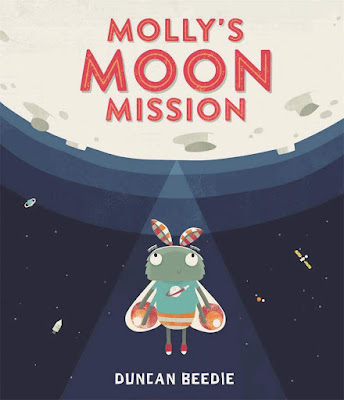Friday, 8 March 2019
To celebrate World Book Day, here's a super-special guest post from Duncan Beedie, author of "The Last Chip" and the superb "Molly's Moon Mission" (Templar Publishing)
Posted by
ReadItDaddy
at
March 08, 2019
Labels:
Duncan Beedie,
Molly's Moon Mission,
Templar Publishing,
World Book Day Guest Post
A man who is no stranger to our Book of the Week slot has very kindly provided some World Book Day inspiration for everyone, with a fantastic guest post detailing some of the thought processes behind our recent BOTW winner "Molly's Moon Mission".So with a huge thanks to Duncan Beedie, time for a Blog Takeover!!
Whenever I approach writing a picture book I have a tendency to do things 'ass-backwards' (if you'll excuse the parlance!) I am more than happy to admit that illustrating comes far more naturally to me than the actual writing which is why, whenever the first seed of an idea germinates, I usually dive right in with character designs, spread compositions, and even the cover design before the story has been fully written. This is no doubt attributed to the fact that I worked in animation for 14 years - a particularly visual form of storytelling - before I made the transition into children's books.
Working on my latest book, Molly's Moon Mission,was no different. If anything, I was even more eager to leap into the visual design of the story as it was to feature an all time favourite topic of mine – space!I was a pretty typical kid of the 80s growing up, fuelled by a healthy consumption of pop culture and sherbet dib-dabs. I marvelled at films such as Star Wars and Battle Beyond The Stars, and TV shows like Buck Rogers and Battlestar Galactica (yes, the old one). My bedroom walls were mostly adorned with posters of the NASA space shuttle, while luminescent stars and moons were scattered across my ceiling.
As a 40-something father to a young child, I am aware that many of the parents who read my stories to their kids will probably share the same childhood influences as myself. For this reason, I like to scatter a few crumbs of nostalgia here and there as a sort of fragile nod of acknowledgement across the sometimes terrifying void of parenthood. Scant consolation, I know, when the bedtime routine isn't going quite as planned. But being reminded of a childhood toy or film can at least soften the blow of being booted repeatedly in the face by a writhing toddler as they settle down for sleepy-byes.
On the theme of revisiting my childhood, taking Molly's Moon Missionon tour has allowed me to fulfil one particular childhood ambition – it's given me the excuse to buy my very own orange aviation suit to wear at book events. The me from 1984 would be doing zero gravity somersaults about this. I'm not ashamed to admit that I get a rather adolescent pang of excitement when I zip myself into it, and like to feel that I have at least an inkling of what it must have felt like for Yeager, Armstrong et al when they were getting suited and booted before a death defying mission. Plus it has the most incredible array of pockets – six of them just for pens!
They are a must for any author / illustrator!
Huge, huge stellar thanks to Duncan for a totally brilliant guest article that tickled my nostalgia and gives some fab insights into the picture book process.
"Molly's Moon Mission" by Duncan Beedie is out now, published by Templar (kindly supplied for review).

















